Watering & Care Instructions
Helpful Lawn Care Instructions
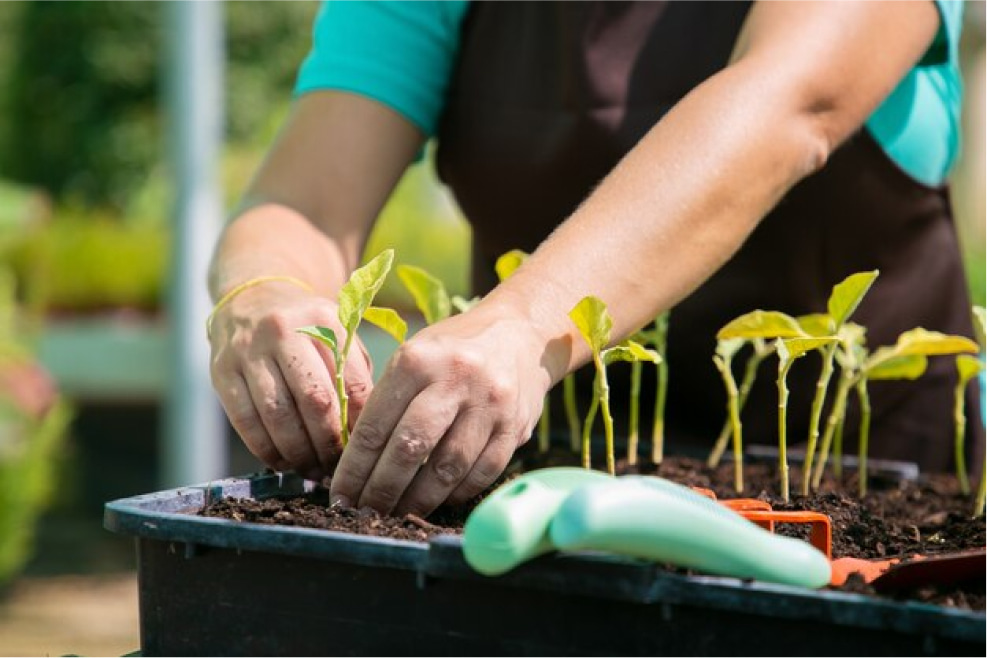
1. New Seed:
Proper watering for new seed can be a little tricky. The most important thing to remember is the seed needs to stay damp 24 hours a day, 7 days a week. But… you don’t want puddles developing in your yard either, as it will float the grass seed and create patchy areas. Achieving this can take a little more effort than many realize.
There are many variables in determining when to water and for how long. Variables such as the season, temperature, wind, soil type, sprinkler coverage, and sun exposure. All of these variables will have an effect. Don’t become overwhelmed!! I will walk you through step by step.
- Turn on each sprinkler zone individually one by one and write down the minutes each zone needs to run until the soil becomes dark chocolate brown and water begins to lightly remain on the surface of the ground (not puddling but on the verge). Program each zone to run for the amount of time you wrote down. You will likely notice shaded areas will require less run time and areas with better sprinkler coverage will require less run time. For pop-up sprinklers these time will likely be 4-8 minutes per zone and rotor or impact sprinklers 8-15 minutes per zone.
- Now you will need to set the sprinkler timer to run through the sprinkler zones more than 1 time per day, as the water will soak into the ground and evaporate throughout the day. The ground needs to remain the chocolatey brown color 24/7. How many times you run the sprinklers throughout the day will vary mostly according to the season, wind, and air temperature (higher temperatures and more wind equals more evaporation). In the spring this may be 2-3 times per day evenly spaced out (every 8 hours), in the middle of the summer you may need to water 5-6 times per day. This is something you will have to monitor until you get it dialed in. It may take a few days of tinkering until you find the sweet spot. Your grass will not germinate (begin to grow) unless the seed stays damp.
- As long as you are watering correctly your grass should be sprouting between the 7-14 day mark. Do not walk on or have traffic of any kind on your newly seeded areas until the grass starts to thicken up. New grass sprouts are very fragile and easily damaged. Keep traffic to a minimum until grass is 2-3” high in all areas. Once the grass has reached 2-3” high in all areas reduce watering to normal levels. Once the grass has reached 3” in all areas you may begin to mow your lawn.
- You may over seed any thin areas at this time however most grass types are naturally spreading and will naturally fill in throughout the course of the season.
- You may apply a high grade fertilizer around the 30 day mark (or have us do it for you). Do not apply any sort of weed control at this time. The grass is still too fragile.
- You may apply fertilizer and weed control around the 75 day mark (or have us do it for you). When seeding a lawn it is very normal to have weeds breakthrough.
- From here follow proper watering instructions for lawn below.
- Sound complicated? It can seem a little complicated at first, but the more familiar you become with your sprinkler system, and your sprinkler timer the more simple it will become. If you ever need help, you can always give us a call and schedule our sprinkler tech to assist you.
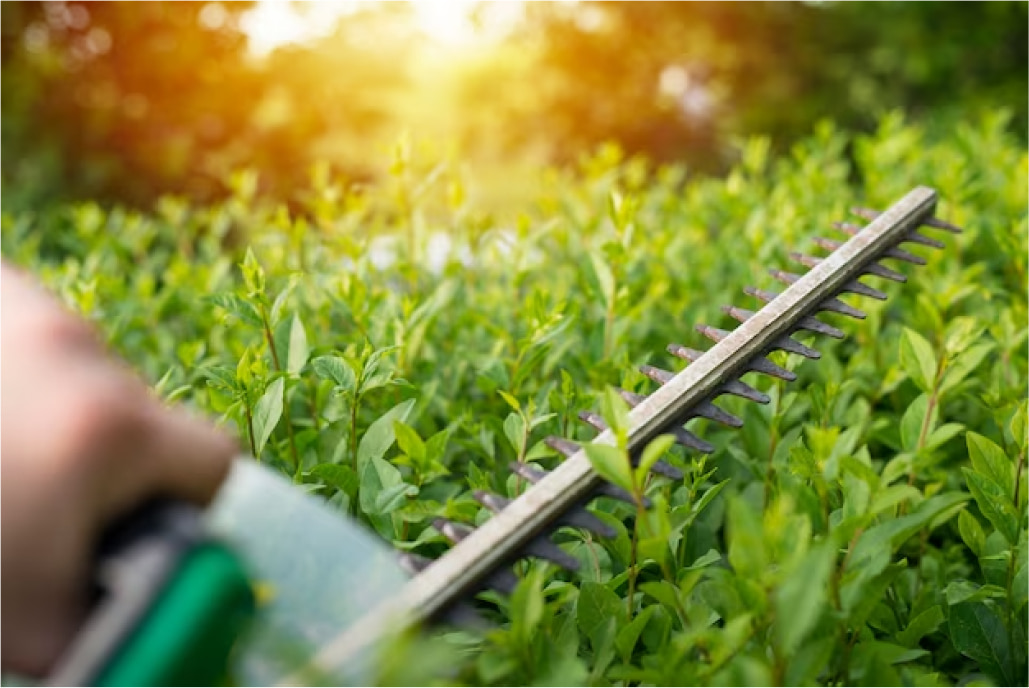
2. Trees and shrubs:
New trees and shrubs may take up to 2 seasons for the roots to start growing outside of the root ball from the nursery. The first 2 seasons are an extremely important time in terms of watering and fertilizing, primarily if the plants and trees are watered by drip irrigation. There are many variables in determining when to water and for how long. Variables such as the season, temperature, wind, soil type, sprinkler coverage, and sun exposure. All of these variables will have an effect. For new trees and shrubs it is important that the soil remains damp (not muddy) at the base of the tree or shrub for the first 2 seasons. The easiest way to check this is to take a handful of dirt in your hand from the base of the plant and squeeze it. You want the dirt to easily compact and hold its shape in your hand once you relieve pressure, but you don’t want water dripping out of your hand when you apply pressure (muddy). The dirt should be a nice chocolaty brown color but not muddy. Too much water can rot the roots out of your new plants or trees but too little water and they will not survive. This is something you will need to monitor for the first 2 seasons. You will need to monitor it after the first 2 seasons as well but…. The first 2 are the most important. How do you accomplish this?
- If your plants are run on drip irrigation, start a watering cycle of 20-30 minutes per day as an initial test. Run the drip in the morning. Go out in late afternoon and check your plants. It is ok for the top ¼” of soil to not be damp as it has been exposed to the air all day. Once you get below the top ¼”, if the soil is not still damp from the morning cycle then you will need to add an afternoon drip cycle to the schedule. Check your plants again the following day. If the ground is now muddy you may need to run a shorter morning and afternoon cycle to dial everything in. It may take a few days of tinkering to hone in the perfect amount of run times versus number of times per day to water.
- Remember…. In the spring and fall your plants and trees will require less water than in the middle of the summer. Your plants don’t actually consume more water in the summer but you lose more water to evaporation due to the heat. In the summer you will have to run your drip irrigation or sprinklers substantially longer than in the spring or fall to get your plants the same amount of water. What does this mean? It means that you will need to monitor your plants and trees water needs throughout the season to account for current changes in weather.
- Sounds complicated? It can seem a little complicated at first, but the more familiar you become with your sprinkler system, your sprinkler timer, and your new plants and trees, the more simple it will become. If you ever need help, you can always give us a call and schedule our sprinkler tech to assist you.
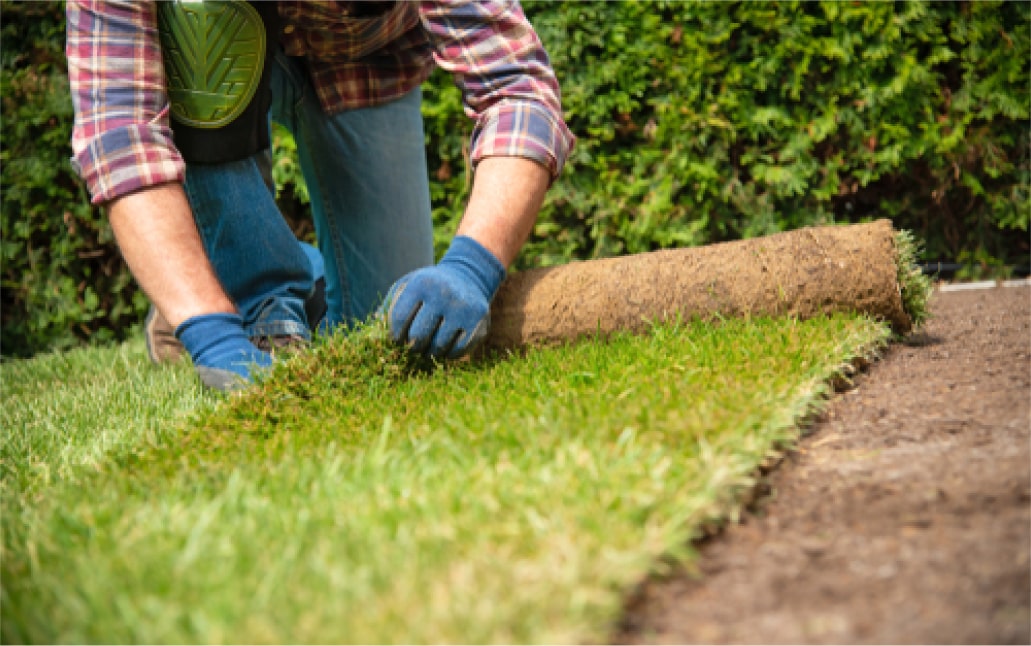
3. Sod
Getting going on sod is much simpler than seed. Grass seed may take up to two months or more to establish where sod will usually only take 2-3 weeks. Here is how you get going.
- The initial setup is very similar to seed. You will want to water multiple times a day for the first couple weeks and keep traffic to a bare minimum. You want the new sod to be well saturated. It needs to be right on the verge of being muddy without being muddy. The sod needs to maintain this moisture level 24/7 for the first two weeks. Please review the “new seed” section for initial setup.
- After the first 2 weeks you will need to do a “root check” on your new sod. Walk out on your new sod and grab a piece of sod in your hands. Firmly pull up on the sod. Do not attempt to rip it out of the ground but pull up firmly. If the roots have not yet attached to the ground the sod will pull up with no resistance, if the sod has begun rooting it will hold pretty firmly to the ground. If the sod has not begun rooting continue the same watering schedule as before for an additional week and recheck.
If the sod has begun to root over the entire lawn, then move on to the “properly watering your lawn” section and begin a normal watering schedule.
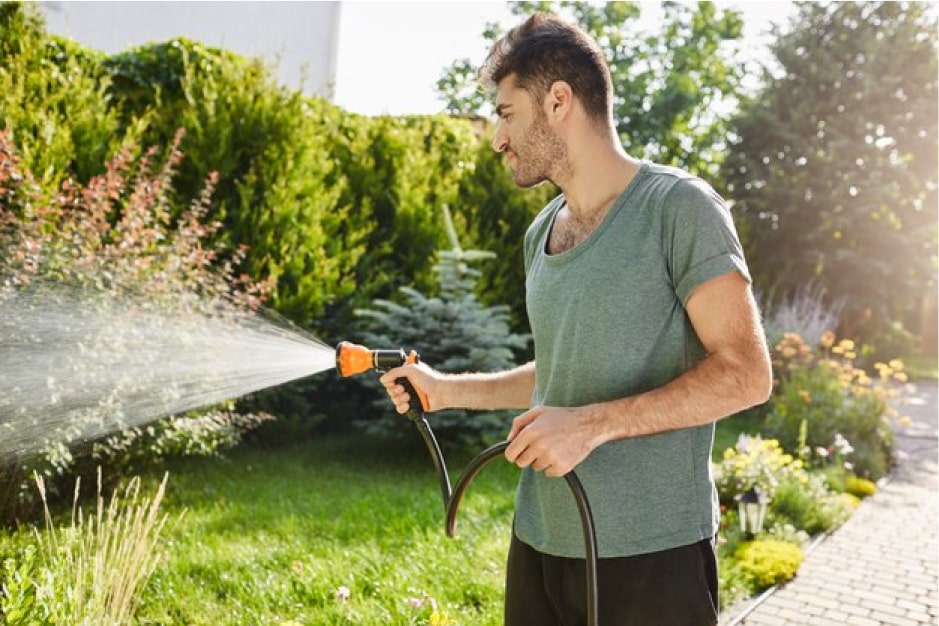
4. Proper Lawn watering:
Improper lawn water is one of the most common problems we see from a professional standpoint, on a regular basis. Not only does it create more problems for your lawn but also degrades the services you pay us for (lawn fertilization, weed control, lawn mowing). Properly watering your lawn will give you the best results for the services you pay for and ultimately a healthy lawn.
Helpful Watering Instructions
Overwatering problems:
Shallowly rooted plants are easily stressed. When the roots of the turf plant die due to lack of oxygen, the plant is put under stress. This, in turn, makes them more susceptible to disease and insect damage. Minor disease and insect problems can become major lawn disasters when a lawn is shallowly rooted. Overwatering your lawn can cause a plethora of problems, including:
- Shallow root depth
- Thatch
- Several different types of fungus some of which will kill your lawn, i.e. mushrooms, ferry rings, dollar spot, rust, necrotic ring spot, grey leaf spot, brown patch, Pythium blight
- Several types of molds which can kill your lawn, i.e. snow mold, sooty mold
- An abundance of insects and added insect pressure
- Moss
- Root rot
- Will exaggerate grass thinning, especially in shade areas
- Will help proliferate slugs
- Dead soil, basically the nutrients are washed out of the soil from excess water. Excess water will also degrade fertilizer when applied. Overwatering will wash fertilizer straight through the soil.
- When you mow your lawn you will leave divots, rip grass out by the root, create “turning spots” in the lawn from turning the lawn mower, long spots from grass layover and clumped grass. Mowing wet grass also puts extra stain on your lawn mower reducing its life. Grass needs to be cut dry.
- Overwatering can also cause rapid grass growth. When mowing grass, you should never remove more than 1/3 of the plant at any one time or it can put the grass into shock and leave it susceptible to other issues. This can cause the grass to brown for up to 2 weeks until the grass recovers.
- Weed control measures have severely reduced effectiveness.
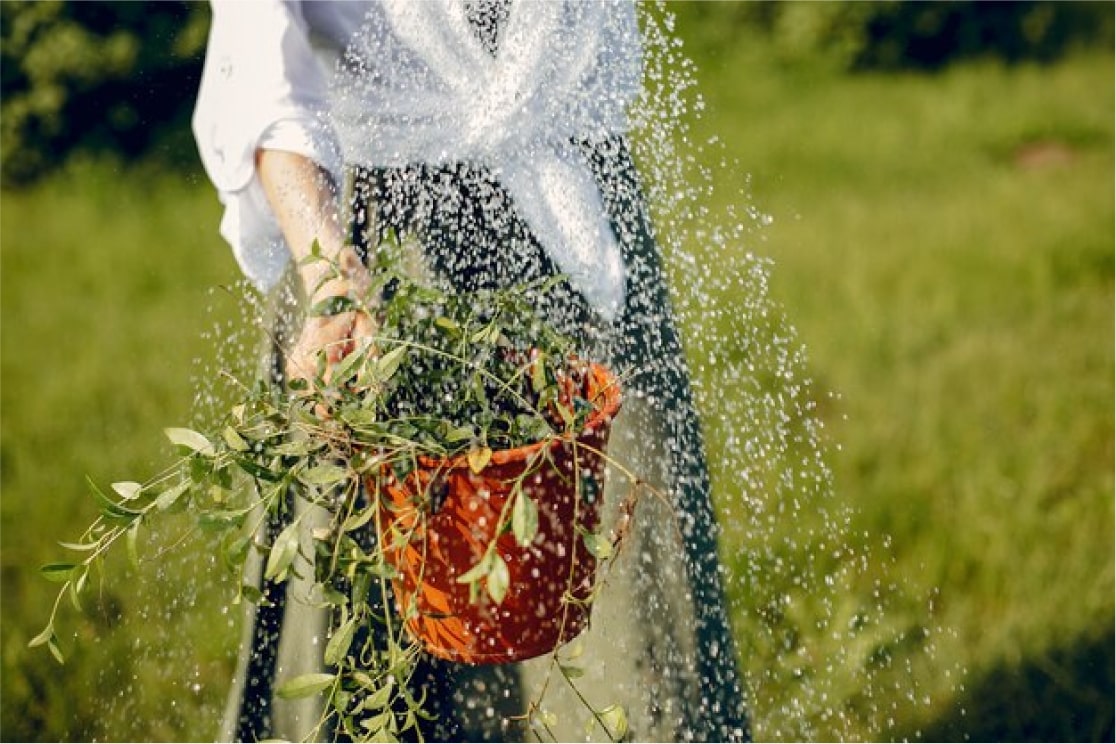
Under watering problems:
The issues associated with under watering grass are much simpler but can still cause very real long term problems. When grass does not get enough water it goes into a dormancy phase. This dormancy is very similar to what your grass does during the winter months. However unlike the winter, if the grass does not start receiving water it will begin to die. Just because your grass begins to brown off in the summer heat does not mean it is dead but it does mean you need to act as quickly as possible to prevent permanent damage. Once the grass starts receiving adequate water it will generally fully recover in 1.5 – 2 weeks. Here are a few common issues associated with under watering:
- Your grass will not be green
- Your grass will die off
- Your fertilizer will not be effective, fertilizer needs to be watered in to the soil so it can be taken up by the roots of the grass. This will also affect pre-emergent.
- Weeds…. Most weed varieties in Idaho thrive in dry areas. The other issue is that dry areas prevent healthy root structures in grass making it much easier for weeds to “crowd out” your grass.
- Most grass varieties do not have an advanced root structure capable of storing water nor can water be stored in the leaf structure of most varieties. Grass is not like most trees and shrubs that have the capacity to store water. Grass only has the capability of taking in the water which is currently available in the soil. Which means, most grass varieties need to be watered regularly.
- Under watered grass is not healthy and has diminished root structure which leaves it more susceptible to disease and bug problems.
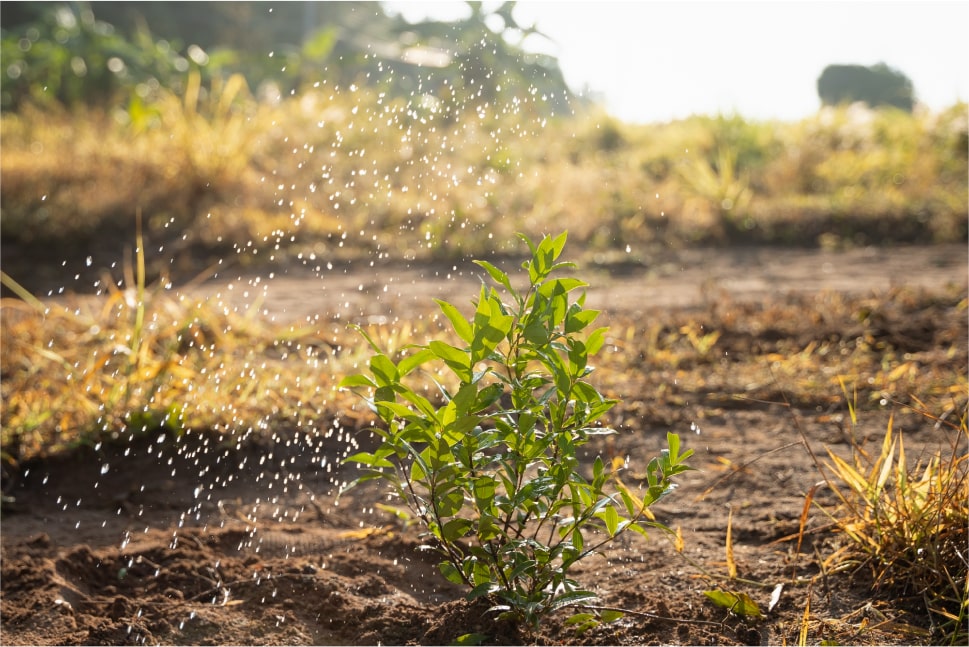
Properly Watering Your Lawn:
Properly watering your lawn will prevent disease, bug problems, weeds, and help ensure you get the most value out of the services we provide. It will not only help create a beautiful lush lawn but also help your lawn create proper root structure and help build your soil. You can fertilize and treat weeds correctly but if the lawn is not watered correctly…… all of the time, money and effort put into your lawn will be wasted. Proper watering is one part of four key ingredients you need for a healthy lawn. The four items are fertilizing, weed/bug control, proper mowing, and proper watering. You can do all of these things correctly but forget one, and they all fall apart.
There is actually a science dedicated to properly watering plants. It is called the science of Evapotranspiration which is mostly employed in the agricultural industry. Definition of Evapotranspiration is the process by which water is transferred from the land to the atmosphere by evaporation from the soil and other surfaces and by transpiration from plants. Basically, every plant needs a certain amount of water to survive and be healthy but there are outside factors at play that create restriction to how much water the plant actually receives. Evaporation is the key factor. The two most common factors into how much water is evaporated are air temperature and wind. Your lawn needs more water during high heat months because of the effects of evaporation (this is a basic explanation). Therefore the amount you water your lawn in the spring and fall will not be the same amount you water during the heat of the summer. The actual water needed by your lawn will change almost monthly to account for current weather, which means your watering schedule for your sprinklers needs to be adjusted monthly. There are other factors as well.
Soil type is another factor. I will not go into great detail but the most common types of soil in this valley are loam, clay, and sand. Each of these soils retain water in different ways, which means you will water differently in clay soil vs loam or sand.
The last major factor is the type of grass we are watering. The most common grass used in the valley is Bluegrass. Bluegrass has an average rooting depth between 2-6 inches. Since most grass varieties have no real way of storing water, the only water the Bluegrass will have access to, is the water in the first 2-6 inches of the soil. For this reason, “Deep watering” will generally not work for Bluegrass. Knowing the type of plant you are watering and watering accordingly is very important.
How to set up a watering schedule:
There are all sorts of “how to” instructions or videos online on how to set up sprinkler schedules. The problem is that everyone’s soil conditions, sun exposure, type of grass, wind exposure, and sprinkler coverage are different. Which means there are too many variables from one property to the next to give specific watering times to each property and have them be accurate or specific to the needs of your property. You will have to spend a little time on your property with your sprinkler system to get everything functioning correctly. This is how you achieve that:
- The first thing you want to do is set up a generic watering schedule. This will be used as a baseline so that you know how to proceed further. You will set up a program on your sprinkler system and then let it run for one week. DO NOT make constant changes every couple days. If you make continual changes throughout the week you will have no idea what changes were positive and which were negative. You need this sprinkler program to run for a week so that you know what changes you need to make moving forward.
Generic initial setup:
Type Of Sprinkler | Spring | Summer | Fall |
|---|---|---|---|
Pop up | 15 minutes 2-3 times per week | 20-25 minutes up to 6 times per week | 15 minutes 2-3 times per week |
rotor/impact | 30 minutes 2-3 times per week | 45-50 minutes up to 6 times per week | 30 minutes 2-3 times per week |
(If you live in the foot hills and have sandy soil your watering schedule will be a little different, give the office a call and we can go over a few different schedules).
- Now that you have run the generic sprinkler program for a week, take a walk around your yard. If overall your grass is green and your lawn is not wet and muddy you are probably pretty close to where you need to be. If the entire lawn is still dry, try adding another day of watering to your schedule. If most of your lawn looks good but there is one section that is muddy or getting too much water, then locate that sprinkler zone on your system and turn down the run time on that particular zone only. If your whole lawn looks good except there is a dry area, locate that sprinkler zone on your system and turn the run time up on that particular zone only. Don’t make changes to the entire sprinkler system if you are only having problems in one area.
When adding or lowering run time to individual zones, only make small changes. Small changes can go a long way. For instance try adding 5 minutes. If you are already watering 15 minutes 2-3 days a week and the grass is still a little dry, increase the watering to 20 minutes 2-3 days per week. After you make these changes wait a week to see how your changes have affected your lawn. DO NOT make constant changes every couple days, it will ruin any progress you have made.
- Now that you have made some adjustments from the week before walk around your lawn and note any problem areas. By this point however you should be very close or already have your sprinklers dialed in. Repeat step 2 for any fine tuning on individual sprinkler zones.
- After you have “dialed” in your sprinkler system, changes from here become easier. Now as the season becomes warmer or cooler you simply need to add or subtract days from your water schedule. Early spring, you may be water 1 day a week and as the season gets warmer you will add more days to the watering schedule. By July when it is 100 degrees you may be all the way up to 6 days a week you are watering. As the season cools, usually starting the second week in August, you will begin to remove days of watering until the season ends. For the first season take notes on changes you made throughout the season. It will make the following season extremely easy.
- As you become more familiar with your lawn and your sprinkler system you will start to notice a few things by default. You will notice shaded areas need substantially less water than areas in full sun, or you will begin to recognize how much wind and air temperature affect the water your grass uses and needs. Remember….. If you ever need help Organic Solutions! Inc. would be happy to schedule a sprinkler tech to assist you. 208-884-8986
Special tips
- Never water the same day as mowing. In fact, if you can resist the urge not to water the day of mowing or the day before it will vastly improve the quality of lawn mowing
- Do not be scared to water multiple days in a row. During the heat of the summer I will commonly water my personal lawn 6 days in a row and leave one day of the week for mowing.
- Do not water the same day as any weed treatment. Grass should not be watered for 24 hours following any weed treatment!
- Fertilizer and pre-emergent need to be watered in as soon as possible
- If fertilizer and weed control have been applied at the same time wait 24 hours before watering.
- Sand!!! Watering in sandy soils can be a little more challenging. If you have sandy soil give us a call and we can go over a few different watering schedules.
- Some sprinkler issues need professional help, you may need adjustments, repair, replacement of certain components, etc…. If you are having a persistent problem give us a call and we can schedule our sprinkler tech to assist you. 208-884-8986
